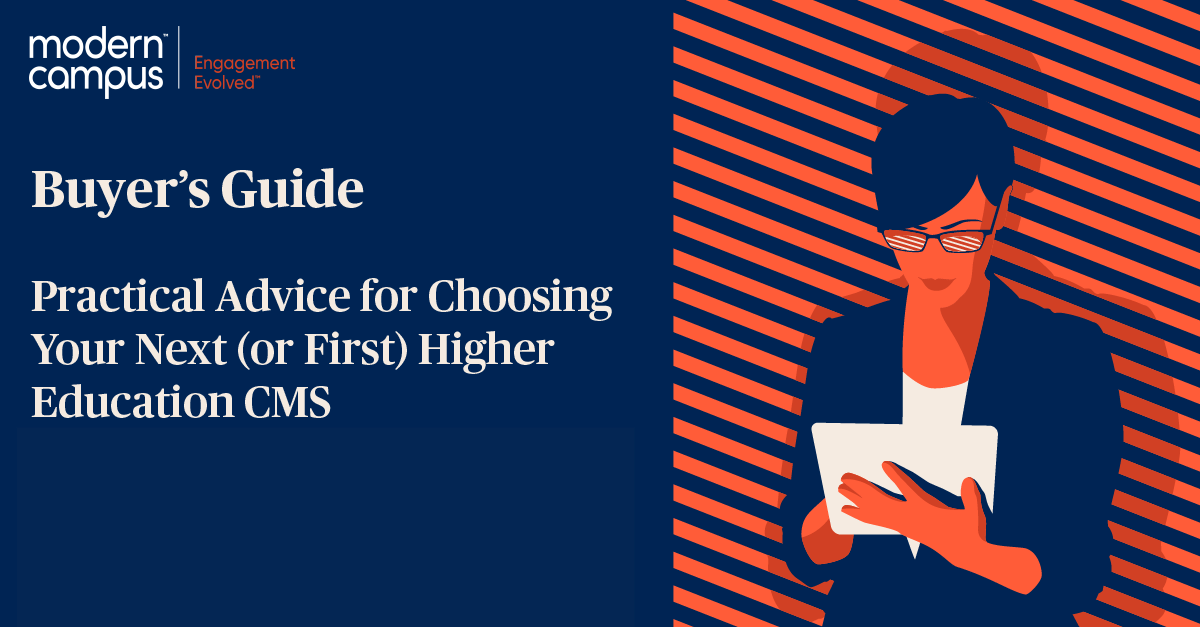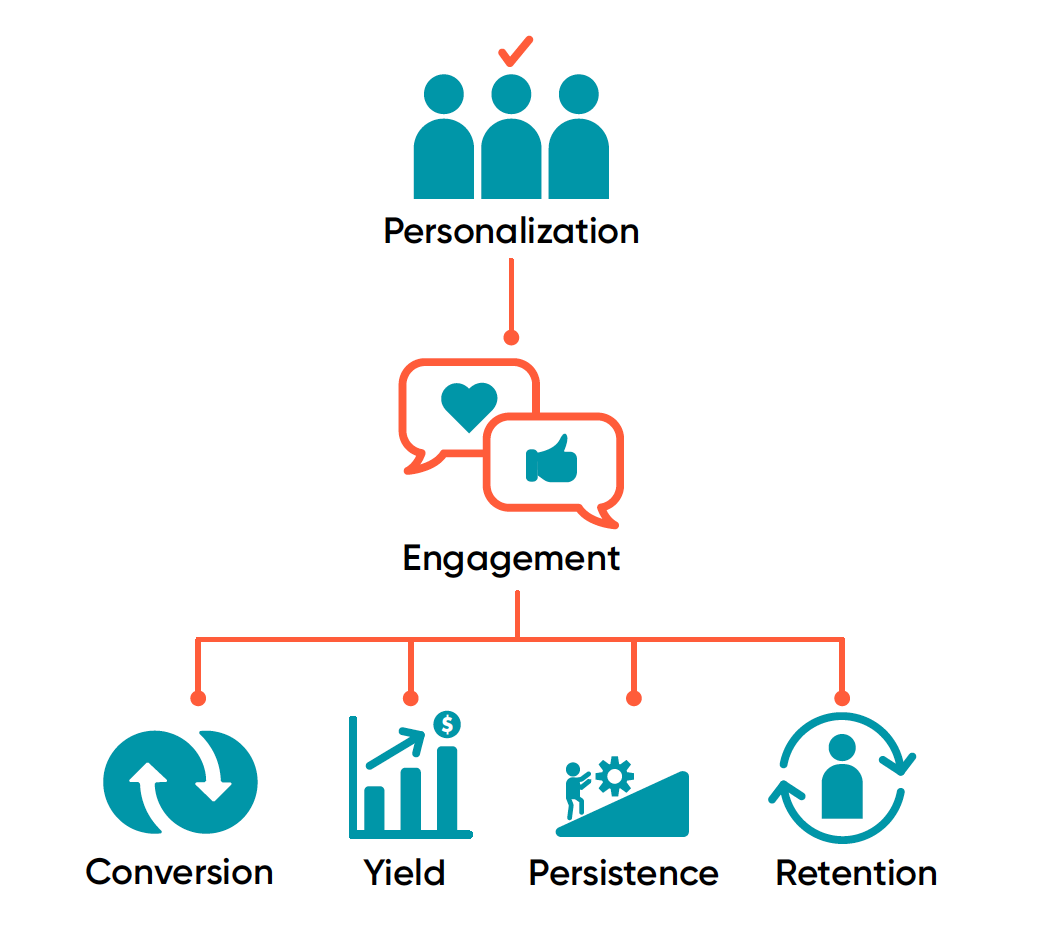
Introduction
Higher education institutions are facing radical transformation. Infrastructure is stretched to capacity. Revenue and enrollment continue to decline. Learner demographics have shifted, demanding that educational institutions deliver programs and outcomes that result in employable skills. Disruption in the marketplace is causing a massive shift to engage modern learners at every stage of their academic journey.
And yet, with radical change comes tremendous opportunity.
Will your web content management system (CMS) help your college or university keep pace? Connectivity is key in the rapidly changing higher education landscape.
- Challenges of Effective Content Management
- The Solution: A CMS Purpose-Built for Higher Education Where to Start
- Purpose-Built for Higher Ed: Why It Matters Commercial CMS vs. Open Source
- Core Features
- A CMS for the Modern Campus
- Finding the Right Fit
- 5 Questions to Ask Before Purchasing a CMS
- Next Steps
Download Buyer's Guide
Challenges of Effective Content Management
Static, Non-Engaging Website
If your website is confusing and impersonal, students will simply go to another school’s site to get the information they need
Lack of Support
Going it alone is not easy—and it’s a drain on time, talent, and budget.
Security
Open-source CMSs are frequently breached and risk exposing critical systems and data to attackers.
Accessibility
Not only do barriers to access limit your audience, they can result in hefty fines.
Missing Functionality
Are you “making do” with a one-size-fits-all CMS that’s not purpose-built for higher ed?
Hard-to-Use CMS
Workflow bottlenecks and web sprawl from a clunky CMS leads to frustration and decreased productivity.
Disconnected Systems
Siloed systems that lack platform integration cause huge roadblocks to productivity and progress
The Solution: A Content Management System for Higher Education
Your website should be 100% focused on the needs and expectations of the students you serve
When today’s students engage with your website, they expect a massively personalized experience like Netflix and Amazon deliver. It’s an experience that’s immediate, relevant, intuitive and friction-free.
Yesterday’s static, bloated website no longer gets their attention—or represents the modern campus that your college or university is aspiring to be.
However, with a student-first web engagement platform, your college or university will have a powerful tool to deliver a highly personalized, high-conversion web experience that engages modern learners for life.
Don’t settle for an off-the-shelf CMS. Instead, invest in a purpose-built content management system that is uniquely designed to address the needs of higher ed.
73%
of higher ed professionals say that their college or university should play a leading role to deeply engage students to facilitate registration.
90%
of higher ed professionals rate their website as ineffective in driving student 90% engagement, enrollment and retention.
20%
of high school seniors will remove a school from 20% consideration if the website is diffcult to use.
Where to Start
A content management system allows multiple users to manage content and makes it easy to display that content digitally.
There are many content management systems on the market, but some are more effective than others at managing the complexity and nuances of the higher ed market.
The real difference between vendors comes down to support, security, ease-of-use, extensibility and engagement that a content management system can provide.
What should you look for in a content management system for Higher Education?
- A web management platform that transforms one-time students into lifelong learners through massively personalized student engagement.
- A system with a 100% higher ed focus that robust product capabilities and a complete solution with modules and partnerships to serve colleges and universities.
- An easy-to-use tool that lets any non-technical user quickly organize, create and manage compelling content without fear of botching brand consistency.
- A system backed by comprehensive customer support driven by a customer-focused product roadmap aligned with higher education goals
- A hub of connectivity and integration for your modern campus where content flows seamlessly from system to system to system.
How does a CMS impact enrollment and revenue?
Your marketing and recruitment campaign is only as good as your CMS. When schools fail to deliver a highly personalized digital engagement experience, it creates a modern learner engagement gap.
A purpose-built CMS, however, capitalizes on your website’s marketing and communications potential by amplifying your school’s messaging so that recruitment, enrollment, retention and marketing strategies reach your intended target audiences.
Purpose-Built for Higher Ed: Why It Matters
Higher ed has unique requirements dictated by technology, government regulations and student needs that don’t apply to other industries. For example, digital accessibility is mandatory in higher ed.
It’s also essential to provide students with searchable course catalogs, faculty directories and calendars. As for web governance, administrators are managing websites that are much larger than those in other industries—making it essential for them to set designated approvers to streamline publishing and control quality.
The entire ecosystem of a content management system for higher education should be designed with these considerations built explicitly into the platform. A purpose-built CMS for higher ed will help you and your team:
Innovate
A CMS for higher ed is customizable with full access to all HTML, CSS, scripting and templates.
Succeed
A CMS for higher ed is designed with easy-to-use tools that simplify and streamline your job—and it’s backed by as little or as much tech support as you need.
Scale
As your needs multiply, a CMS for higher ed lets you add modules and open APIs to integrate with all the required systems and external apps.
Control your message
A purpose-built CMS features workflows, accessibility controls, user permissions and nonbreakable templates so that your school’s brand and message stay consistent throughout your website.
Create community
A CMS for higher ed means that every customer works at a college or university, giving you and your team instant access to a nationwide partnership of likeminded professionals, partners, and industry experts.
Modern Campus is always ahead of the curve. For example, if there is a new accessibility rule, they go ahead and build a check into the software. Because of their expertise and market knowledge, they are solving problems for us before we even know what the problems are. It is extremely valuable to have resident experts on hand who stay current with trends.
Commercial CMS vs. Open Source
It’s easy to get swayed by the advantages of open source—until your system is hacked due to a simple plug-in and your team discovers that one-size-fits-all actually doesn't.
Before committing to a system not purpose-built for higher ed, consider the potential high cost of an apparently "free" open-source CMS. An open source-CMS:
- Is vulnerable to malicious viruses and cyber attacks.
- Tacks on added costs for support—it’s not included with the CMS.
- Is not as user-friendly as some commercial CMS products.
- Lacks automatic updates, requiring dedicated staff to stay abreast of updates and maintenance.
- Requires pricey and significant customization of design and templates to meet specific institutional needs.
Four Questions You Should Ask Before Considering an Open Source CMS
Educate yourself on the pros and cons of using an open source web content management system.
More than 70% of WordPress installations are vulnerable to cyberattacks. One study found that out of the 42,106 WordPress websites included in Alexa’s top 1 million websites, there were 74 different versions of the software—11 of which were invalid. Only 18.55% of those sites were updated to the latest version and 1.82% of the sites were still running a version of WordPress 2.0.
Statistics Show Why WordPress Is a Popular Hacker Target, June 25, 2020
The cost of a free CMS like Drupal is deceiving. It is true that Drupal is a free open-source CMS, but implementation costs around $30,000-40,000; if you customize as institutions often do, those numbers can reach $100,000 or more. And that’s not counting the fees for security, maintenance and migrations that are notoriously challenging.
21+ Stunning Drupal Stats Each Website Owner Should Know
Core Features
Both modern learners and modern administrators expect a highly personalized, high-conversion web experience.
Let’s take a look at the core features that a modern, purpose-built content management system for higher education should deliver.
1. Highly Engaging Student-First Experience for the Modern Learner
The future of the modern campus is massive personalization at every touchpoint.
This type of evolved engagement begins with a CMS that is purpose-built to meet the important and unique needs of students and the institutions that serve them.
A modern CMS supports a student-first approach so that every interaction a student has with your college or university is positive and affirming.
Why this matters to your higher ed institution:
- Dynamic career and program explorer embeds within academic and program pages so that students can align education goals with career goals.
- Branded academic catalog and faculty directory simplify searches and are easy to navigate.
- Custom alerts post updates quickly from any device.
- A net price calculator presents the true cost of a college education in black and white.
- Dynamic maps and virtual tours with 360 panoramas, videos, photos, narrated
audio and more creates a rich virtual experience. - Email campaign manager gets the right message to the right person at the right time. Interactive, centralized calendar builds community.
- Interactive, centralized calendar builds community.
We use Modern Campus CMS to reduce bottlenecks and increase efficiency. Once things that can be automated are automated, we allow our staff to do the uniquely human things. This way our experts can focus their time and energy on what they do best. It comes back to the human-first approach, but relies on technology to be successful.
2. Easy-to-Use Content Management
Your subject matter experts should be focused on supporting students and planning programming—not trying to figure out how to upload information or design a web page. As such, a purpose-built CMS for higher ed should be as easy to use as Word.
No advanced tech skills are needed to freshen and change out content.
Any contributor can use the CMS to keep your website up to date and relevant in the changing educational landscape.
Why this matters to your higher ed institution:
- Drag and drop features streamline content creation and maintenance. Edit once to
update all pages throughout your site. - Decentralized content contributors are supported with tools like in-context editing and tag management.
- Simple content approval includes instant publishing, multi-browser preview and multi-output preview.
- Fail-safe tools let administrators enforce spelling, link, W3C validation and accessibility checks before publish.
- A one-stop interactive hub displays content from all of your institution’s social channels.
A developer can work with anything, but the majority of users have simple technological skill sets. They might not understand how a website or CMS works, but they know that they can drag and drop content and publish it. Therefore, people of all technical skill levels need to be able to use it. Fortunately, we have flexibility with Modern Campus CMS.
3. Streamlined Reporting and Governance
Your job is complicated enough. That’s why you need a CMS that isn’t.
A purpose-built CMS for higher ed streamlines and simplifies time-consuming, tedious processes such as reporting and workflows so that it’s easy to manage users and control quality.
Why this matters to your higher ed institution:
- Custom reports and audits can be generated instantly, whether you need an accessibility compliance update or a list of broken links.
- Immediate accessibility enforcement keeps your website compliant.
- Scan tool finds and offers solutions for weak SEO, accessibility issues, invalid links and misspellings.
- Built-in Google analytics optimize content based on metrics of visitor behavior.
- Interactive dashboards make it easy to monitor your institution’s online presence.
- User permissions can be defined to match roles and design seamless workflows down to site, page or even a section of a page for better multi-site, multi-user and multi-channel administration.
Modern Campus CMS made my job easier—so easy that by implementing the CMS, half of my job responsibilities went away. I no longer have to perform mundane content updates, but can now focus on what I really want to do.
How To Create a Web Governance Strategy
Website governance is crucial to the integrity of your higher ed institution’s website. Watch our webinar to get on track for success!
4. Superb Training and Customer Support
A reliable CMS partner understands that most higher ed tech departments are small or stretched thin. That’s why a purpose-built CMS for higher ed should be backed by a customer support team to fill the gaps in staff resources for your college or university.
Responsive customer service that keeps your team working with minimal downtime along with frequent and informative training sessions that help new and existing customers stay up to date should also be part of the partnership.
Why this matters to your higher ed institution:
- Why this matters to your higher ed institution:
- Customized onsite and remote training opportunities educate your institution’s end users, administrators, trainers or developers.
- 24/7 support site and knowledge base gets answers quickly.
Modern Campus provides a different level of service. It’s great to have good customer service when you have routine issues, but in drastic situations like a Category 4 hurricane, it’s a necessity to have Modern Campus on your team.
Feature 5: Fail-Safe Security
Educational institutions are the third most frequent target of hackers, costing schools upwards of $200 per student to rectify. Even more sobering is that 64% of students don’t feel that their college or university is prepared to keep their data safe.
That’s why it pays to invest in a purpose-built CMS that meets modern security standards and automatically updates. It also saves your team valuable time and staffing resources since they won’t have to keep your system up to date.
Why this matters to your higher ed institution:
- Automatic security updates and patches keep your CMS up to date at all times.
- Seamless security upgrades free your IT team to focus on priority projects.
- HTTPS validator ensures all URLs managed in CMS are secure—and even if not enabled, pages with sensitive information are served over HTTPS.
- Single Sign-On (SSO) supports LDAP over SSL, CAS and Shibboleth for SaaS deployment.
- Continual monitoring by experienced technologists identify problems before they become security concerns.
I like Modern Campus CMS over an open-source solution because there is an extra feeling of security. I want to make sure I don’t get a call at 2 am saying the website is down. I have comfort knowing that the system is solid and proprietary, and that Modern Campus professionals who know the ins and outs of the system are there if I need them.
6. Robust Extensibility and Integration
The digital infrastructure of higher ed is a web of different systems that must work together seamlessly.
With a purpose-built CMS for higher ed, you’ll have a digital engagement platform that’s flexible and extensible so that you can integrate these ever-changing technologies as needed to support your school’s growth now and in the future.
Why this matters to your higher ed institution:
- Comprehensive set of open APIs and gadgets lets developers automate or extend functionality—no need for complicated plugin systems.
- A single piece of content publishes to many output types (HTML, PDF, XML, etc.).
- Production server types and configurations work with just about any server-side language.
- Extensibility accommodates new technologies and needs as they arise—now or in the future.
- Seamless third-party integration with all the systems used throughout higher ed is easy.
- File retrieval is accessible from anywhere. Add as many auxiliary sites as needed
Modern Campus CMS is more intuitive and easier for my small development team to understand and be comfortable with, compared to other products. What swayed our final decision was just the comfort level from a developer standpoint. We needed a technology that we could really believe in and work with.
The Importance of Personalization Designed for Higher Ed
Modern learners expect digital experiences to mirror their best consumer experiences, shaped by the rich personalization that brands like Netflix and Amazon deliver. And web personalization benefits the institution as well. It’s been shown to increase conversion by 19% in education—which increases applications and enrollments.
While a CMS is the foundation for delivering personalized content to students, be sure that its personalization capabilities are designed specifically for higher education. Consider these scenario
- Unknown visitors: When a prospective student makes repeat visits to a specific program page, a CMS for higher ed personalizes messaging through topic relevancy.
- Geolocation data: A CMS designed for higher ed recognizes that the prospective student is in-state and therefore suggests in-state tuition information.
- SIS & CRM integration: Main campus system integrations deliver personalized content to students across the enrollment funnel, reducing summer melt and increasing yield.
- Known users: A true higher ed CMS offers custom calls-to-action promoting club membership and other activities that drive engagement, persistence and completion.
Delivering Career Pathways and Website Personalization at West Valley College
Learn how West Valley College is transforming the student experience by implementing Modern Campus Pathways.
A CMS for the Modern Campus
A feature-rich CMS that’s purpose-built for higher ed supports both your institution’s current goals and long-term vision. It’s time to invest in a next-generation CMS that empowers your college or university to engage modern learners for life.
Choose a Platform That Does It All
Modern Campus CMS is a purpose-built CMS for higher education that offers:
- A highly engaged student-first experience for the modern learner.
- Easy-to-use content management.
- Streamlined reporting and governance.
- Features designed specifically for higher ed.
- Superb training and customer support.
- Fail-safe security.
- State-of-the-art extensibility and integration.
Finding the Right Fit
Finding the right vendor to work with is just as important as the functionality of the CMS itself. Your school needs a partner that understands the unique demands and requirements of higher education and then builds successful solutions directly into the CMS.
Responsive Support
You don’t want a CMS vendor—you want a CMS partner that walks with you every step of the way, from design to migration to implementation. Look for a company that can onboard your team quickly, align resources and set milestones for success. Inquire about response time and access to 24/7 support.
Higher Ed Personalization
Your CMS partner should understand the critical need for schools to deliver a highly personalized digital engagement experience that leads students down a clear pathway from graduation to a job.
Product Innovation
Look for a CMS provider that continually works to improve, maintain and innovate so that your CMS reflects the growing needs of a higher ed ecosystem.
Depth in Expertise
Do you want your implementation to be your CMS provider’s first attempt? Tenth? Fiftieth? Check higher ed references and choose a CMS provider that has worked with hundreds of colleges and universities on implementation and website redesign projects like yours.
Automated Workflow & Compliance Management
A modern CMS should make your job easier with automated administrative tasks such as workflow and compliance management. When there’s less work, there’s more time for your team to innovate and problem solve.
Community of Peers
Chances are that any problem you encounter has already been solved by one of your peers in higher ed. Working with the right CMS provider should give you access to a community of peers so that your school can reap the rewards from the group’s collective knowledge and expertise.
5 Questions to Ask Before Purchasing a CMS
- Is the CMS designed specifically for higher education?
- Is the CMS scalable so that it can continue to support your campus as it grows?
- Where do you go if you have a question about the CMS? Is help available through customer support or detailed documentation?
- Are you able to deliver high-conversion, personalized messaging to modern learners?
- Is the CMS secure and automatically updated?
One of the biggest selling points for us was the higher education focus. Modern Campus CMS immediately stood out as the right solution because it was tailor-made for institutions just like ours.
The Modern Campus CMS platform positions us so that we can really blow open the doors on what we can accomplish. Finally, we have all the tools in place to do what we need to do on a larger scale.
College and University Website Redesign: The Ultimate Guide
Everything you need to know about initiating and executing a website redesign project in higher education.
Next Steps
Choosing the right content management system is a critical step in supporting the future growth, security and reach of your college or university. Consider your specific needs as a higher education institution. Research content management systems used by your competitors.
Speak to an Expert
Ready to learn more about how a purpose-built CMS for higher education can help your college or university keep pace in the rapidly changing higher ed landscape?
Download Buyer's Guide
Featured Resources

Whitepaper
The Complete Guide to Digital Accessibility Compliance for Colleges and Universities
Learn about Universal Design for Learning, accessibility best practices and more.

Blog
The Best CMS for Universities: Which One Is Right for You?
Scalability. Flexibility. Efficiency. Compliance. Read our guide to learn more about the best CMS for universities.

Whitepaper
College and University Website Redesign: The Ultimate Guidec
Learn everything you need to know about initiating and executing a website redesign project in higher education.

Tackle your biggest challenges
